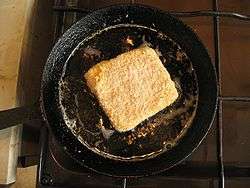Fried cheese
Fried cheese is a dish prepared using cheese that is fried in oil.[1] Fried cheese can be dipped in a batter before frying, and can be pan-fried or deep fried.[2] It can be served as an appetizer or a snack.[2][3] Fried cheese is a common food in Brazil,[1] and is typically served as a breakfast dish in Cyprus, Greece, Lebanon, Syria and Turkey.[4] Fried cheese is served as a tapas dish in Spain,[5] and in Spain fried cheese balls is referred to as delicias de queso (English: "Cheese delights").[6] It is also a dish in Italian cuisine.[7] Fried cheese is typically served hot, right after being cooked.[5][6][8] It may be accompanied with a dipping sauce or coated with a dressing.[5]
History
Fried cheese has been documented as being a popular dish in Cairo, Egypt, during the Middle Ages, and remained a part of the cuisine through the time of the Ottoman occupation.[4] After this period, its popularity markedly decreased with time.[4]
Dishes

Fried cheese curds are cheese curds that have been fried. It can be served with a dipping sauce.[9]
Queso Frito (English: "fried cheese") is a fried cheese dish with several variations around the world.[10] Spanish versions sometimes use paprika to spice the dish.[10] It is also a dish in Central American cuisine.[lower-alpha 1]
Malakoff is a Swiss fried cheese dish.
Mozzarella sticks are slices of mozzarella cheese that are battered or coated in bread crumbs and then deep-fried or pan-fried.[12] The dish can also be baked,[13] rather than fried.
Saganaki is a Greek term that refers to dishes prepared using a small frying pan. The most common saganaki is fried cheese.[14]
Smažený sýr (Czech) or Vyprážaný syr (Slovak) is a cheese that is prepared by being coated in flour, placed in an egg wash and then coated with bread crumbs, after which it is deep fried.[15] It is a common street food in the Czech Republic and Slovakia.[15]
- Fried cheese dishes
 A close-up view of deep-fried cheese curds
A close-up view of deep-fried cheese curds.jpg) Fried mozzarella sticks served with a marinara dipping sauce
Fried mozzarella sticks served with a marinara dipping sauce
- Prepared smažený sýr
Commercial production
Mozzarella cheese is often used by fried cheese food manufacturers, because it has a desirable gooeyness when melted and because it has a neutral flavor that is "widely acceptable".[16]
Health concerns
A significant amount of oil is absorbed into cheese when it is fried, and the frying of cheeses adds advanced lipid end products[17] and dicarbonyls to advanced glycation end-products that are already present in cheeses.[1] The advanced lipid end products are generated in a chemical reaction that occurs when the oil is intermingled with the proteins in cheeses.[1] Furthermore, most cheeses are salty.[1][18] As such, fried cheese has been described as an unhealthy dish.[1]
In Brazil, the chronic consumption of fried cheese has been demonstrated to be one of the dietary risk factors associated with oral cancer incident rates.[lower-alpha 2]
See also
Notes
References
- 1 2 3 4 5 6 7 Losso 2016, p. 38–39.
- 1 2 Parkinson, R.L. (2004). The Everything Fondue Cookbook: 300 Creative Ideas for Any Occasion. F+W Media. p. 42. ISBN 978-1-60550-472-8. Retrieved May 26, 2016.
- ↑ Stern, J.; Stern, M. (2009). 500 Things to Eat Before It's Too Late: And the Very Best Places to Eat Them. Houghton Mifflin Harcourt. p. 223. ISBN 978-0-547-05907-5. Retrieved May 26, 2016.
- 1 2 3 Lewicka, P. (2011). Food and Foodways of Medieval Cairenes: Aspects of Life in an Islamic Metropolis of the Eastern Mediterranean. Islamic History and Civilization. Brill. p. 239. ISBN 978-90-04-19472-4. Retrieved May 26, 2016.
- 1 2 3 Casas, P. (2007). Tapas: The Little Dishes of Spain. Alfred A. Knopf. p. 160. ISBN 978-0-307-26552-4. Retrieved May 26, 2016.
- 1 2 Casas, P. (2014). 1,000 Spanish Recipes. 1,000 Recipes. Houghton Mifflin Harcourt. p. 64. ISBN 978-0-544-30908-1. Retrieved May 26, 2016.
- ↑ Esposito, M.A. (2010). Ciao Italia Five-Ingredient Favorites: Quick and Delicious Recipes from an Italian Kitchen. St. Martin's Press. p. 15. ISBN 978-1-4299-3152-6. Retrieved May 27, 2016.
- ↑ Kordsmeier, K.P.; Geldhauser, H. (2015). Atlanta Chef's Table: Extraordinary Recipes from the Big Peach. Chef's Table. Globe Pequot Press. p. 89. ISBN 978-1-4930-1609-9. Retrieved May 27, 2016.
- ↑ Call, The Morning (May 10, 2016). "Lehigh Valley food truck mania: Three festivals this summer". themorningcall.com. Retrieved May 26, 2016.
- 1 2 Bittman, M. (2009). The Best Recipes in the World. Potter/TenSpeed/Harmony. p. pt218. ISBN 978-0-307-48217-4. Retrieved May 26, 2016.
- ↑ Losso 2016, p. 369.
- ↑ Bronski, K.; Bronski, P. (2013). Artisanal Gluten-Free Cooking: 275 Great-Tasting, From-Scratch Recipes from Around the World, Perfect for Every Meal and for Anyone on a Gluten-Free Diet—and Even Those Who Aren't. The Experiment. p. 74. ISBN 978-1-61519-157-4. Retrieved May 26, 2016.
- ↑ Karmel, A. (2010). Top 100 Finger Foods. Atria Books. p. 45. ISBN 978-1-4391-6495-2. Retrieved May 26, 2016.
- ↑ Salvia, Vanessa (May 25, 2016). "Decoding Greek dishes". The Register-Guard. Retrieved May 26, 2016.
- 1 2 Kraig, B.; Sen, C.T. (2013). Street Food Around the World: An Encyclopedia of Food and Culture. ABC-CLIO. p. 109. ISBN 978-1-59884-955-4. Retrieved May 26, 2016.
- ↑ 1994. "Restaurant Business". Volume 93. Restaurant Business. p. 140. Retrieved 26 May 2016. (subscription required)
- ↑ Losso 2016, p. 164.
- ↑ Losso 2016, p. 209.
Bibliography
- Losso, J.N. (2016). The Maillard Reaction Reconsidered: Cooking and Eating for Health. CRC Press. ISBN 978-1-4822-4822-7. Retrieved May 26, 2016.
External links
-
 Media related to Fried cheese at Wikimedia Commons
Media related to Fried cheese at Wikimedia Commons